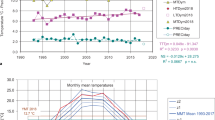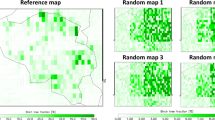Abstract
Climatic change is expected to affect the spatiotemporal patterns of airborne allergenic pollen, which has been found to act synergistically with common air pollutants, such as ozone, to cause allergic airway disease (AAD). Observed airborne pollen data from six stations from 1994 to 2011 at Fargo (North Dakota), College Station (Texas), Omaha (Nebraska), Pleasanton (California), Cherry Hill and Newark (New Jersey) in the US were studied to examine climate change effects on trends of annual mean and peak value of daily concentrations, annual production, season start, and season length of Betula (birch) and Quercus (oak) pollen. The growing degree hour (GDH) model was used to establish a relationship between start/end dates and differential temperature sums using observed hourly temperatures from surrounding meteorology stations. Optimum GDH models were then combined with meteorological information from the Weather Research and Forecasting (WRF) model, and land use land coverage data from the Biogenic Emissions Land use Database, version 3.1 (BELD3.1), to simulate start dates and season lengths of birch and oak pollen for both past and future years across the contiguous US (CONUS). For most of the studied stations, comparison of mean pollen indices between the periods of 1994–2000 and 2001–2011 showed that birch and oak trees were observed to flower 1–2 weeks earlier; annual mean and peak value of daily pollen concentrations tended to increase by 13.6 %–248 %. The observed pollen season lengths varied for birch and for oak across the different monitoring stations. Optimum initial date, base temperature, and threshold GDH for start date was found to be 1 March, 8 °C, and 1,879 h, respectively, for birch; 1 March, 5 °C, and 4,760 h, respectively, for oak. Simulation results indicated that responses of birch and oak pollen seasons to climate change are expected to vary for different regions.







Similar content being viewed by others
References
Adhikari A, Reponen T, Grinshpun SA, Martuzevicius D, LeMasters G (2006) Correlation of ambient inhalable bioaerosols with particulate matter and ozone: a two-year study. Environ Pollut 140(1):16–28. doi:10.1016/j.envpol.2005.07.004
Baechler CM, Williamson J, Gilbride T, Cole P, Heft M, Love MP (2010) Guide to determining climate regions by county. Building americal best practice, vol 7.1. US Department of Energy, http://www1.eere.energy.gov/buildings/residential/ba_climate_guidance.html
Bielory L, Lyons K, Goldberg R (2012) Climate change and allergic disease. Curr Allergy Asthma Rep 12(6):485–494. doi:10.1007/s11882-012-0314-z
Damialis A, Halley JM, Gioulekas D, Vokou D (2007) Long-term trends in atmospheric pollen levels in the city of Thessaloniki, Greece. Atmos Environ 41(33):7011–7021. doi:10.1016/j.atmosenv.2007.05.009
Deser C, Knutti R, Solomon S, Phillips AS (2012) Communication of the role of natural variability in future North American climate. Nature Clim Change 2(11):775–779. doi:10.1038/NCLIMATE1562
Efstathiou C, Isukapalli S, Georgopoulos P (2011) A mechanistic modeling system for estimating large scale emissions and transport of pollen and co-allergens. Atmos Environ 45(13):2260–2276 (Oxford, England: 1994)
Emberlin JE, Detandt MD, Gehrig RG, Jaeger SJ, Nolard NN, Rantio-Lehtimäki AR-L (2002) Responses in the start of Betula (birch) pollen seasons to recent changes in spring temperatures across Europe. Int J Biometeorol 46(4):159–170. doi:10.1007/s00484-002-0139-x
Erkan P, Biçakçi A, Aybeke M (2010) Analysis of airborne pollen fall in Tekirdag, Turkey. Asthma Allergy Immunol 8:46–54
Estrella N, Menzel A, Krämer U, Behrendt H (2006) Integration of flowering dates in phenology and pollen counts in aerobiology: analysis of their spatial and temporal coherence in Germany (1992–1999). Int J Biometeorol 51(1):49–59. doi:10.1007/s00484-006-0038-7
Fitter AH, Fitter RSR (2002) Rapid changes in flowering time in british plants. Science 296(5573):1689–1691. doi:10.1126/science.1071617
Frei T (1998) The effects of climate change in Switzerland 1969–1996 on airborne pollen quantities from hazel, birch and grass. Grana 37(3):172–179. doi:10.1080/00173139809362662
Frei T, Gassner E (2008) Climate change and its impact on birch pollen quantities and the start of the pollen season an example from Switzerland for the period 1969–2006. Int J Biometeorol 52(7):667–674. doi:10.1007/s00484-008-0159-2
Garcı́a-Mozo H, Galán C, Aira MJ, Belmonte J, Dı́az-de-la-Guardia C, Fernández D, Gutierrez AM, Rodriguez FJ, Trigo MM, Dominguez-Vilches E (2002) Modelling start of oak pollen season in different climatic zones in Spain. Agric For Meteorol 110(4):247–257. doi:10.1016/s0168-1923(02)00003-5
Garcia-Mozo H, Galan C, Jato V, Belmonte J, de la Guardia C, Fernandez D, Gutierrez M, Aira M, Roure J, Ruiz L, Trigo M, Dominguez-Vilches E (2006) Quercus pollen season dynamics in the Iberian peninsula: Response to meteorological parameters and possible consequences of climate change. Ann Agric Environ Med 13(2):209–224
Hansen J, Sato M, Ruedy R, Lo K, Lea DW, Medina-Elizade M (2006) Global temperature change. Proc Natl Acad Sci USA 103(39):14288–14293. doi:10.1073/pnas.0606291103
Helbig N, Vogel B, Vogel H, Fiedler F (2004) Numerical modelling of pollen dispersion on the regional scale. Aerobiologia 20(1):3–19. doi:10.1023/b:aero.0000022984.51588.30
Hernández-Ceballos MA, García-Mozo H, Adame JA, Domínguez-Vilches E, Bolívar JP, la Morena BA, Pérez-Badía R, Galán C (2011) Determination of potential sources of Quercus airborne pollen in Córdoba city (southern Spain) using back-trajectory analysis. Aerobiologia 27(3):261–276. doi:10.1007/s10453-011-9195-1
IPCC (2007a) Summary for Policymakers. IPCC Climate Change 2007,The Physical Science Basis, Cambridge
IPCC (2007b) Chapter 2 Changes in Atmospheric Constituents and in Radiative Forcing. IPCC Climate Change 2007, The Physical Science Basis, Cambridge
IPCC (2007c) Chapter 10 global climate projections. IPCC Climate Change 2007, The Physical Science Basis, Cambridge
Jato V, Rodriguez-Rajo FJ, Aira MJ (2007) Use of phenological and pollen-production data for interpreting atmospheric birch pollen curves. Ann Agric Environ Med 14(2):271–280
Kasprzyk I (2009) Forecasting the start of Quercus pollen season using several methods—the evaluation of their efficiency. Int J Biometeorol 53(4):345–353. doi:10.1007/s00484-009-0221-8
Kinnee E, Geron C, Pierce T (1997) United states land use inventory for estimating biogenic ozone precursor emissions. Ecol Appl 7(1):46–58. doi:10.1890/1051-0761(1997)007[0046:usluif]2.0.co;2
Lamb CE, Ratner PH, Johnson CE, Ambegaonkar AJ, Joshi AV, Day D, Sampson N, Eng B (2006) Economic impact of workplace productivity losses due to allergic rhinitis compared with select medical conditions in the United States from an employer perspective. Curr Med Res Opin 22(6):1203–1210
Leung LR, Qian Y (2009) Atmospheric rivers induced heavy precipitation and flooding in the western US simulated by the WRF regional climate model. Geophys Res Lett 36(3), L03820
Masaka K, Maguchi S (2001) Modelling the masting behaviour of Betula platyphylla var. japonica using the resource budget model. Ann Bot 88(6):1049–1055. doi:10.1006/anbo.2001.1547
Mearns LO, Gutowski W, Jones R, Leung R, McGinnis S, Nunes A, Qian Y (2009) A regional climate change assessment program for North America. Eos Trans AGU 90(36). doi:10.1029/2009eo360002
Nakicenvoic N, Davidson O, Davis G, Grübler A, Kram T, Rovere E, Metz M, Morita T, Pepper W, Pitcher H, Sankovski A, Shukla P, Swart R, Watson R, Dadi Z (2000) Special report on emissions scenarios: a special report of working group iii of the intergovernmental panel on climate change. IPCC, Cambridge
Pauling A, Rotach M, Gehrig R, Clot B, CttEA N (2012) A method to derive vegetation distribution maps for pollen dispersion models using birch as an example. Int J Biometeorol 56(5):949–958. doi:10.1007/s00484-011-0505-7
Rasmussen A (2002) The effects of climate change on the birch pollen season in Denmark. Aerobiologia 18(3):253–265. doi:10.1023/a:1021321615254
Shea KM, Truckner RT, Weber RW, Peden DB (2008) Climate change and allergic disease. J Allergy Clin Immunol 122(3):443–453. doi:10.1016/j.jaci.2008.06.032
Siljamo P, Sofiev M, Filatova E, Grewling L, Jager S, Khoreva E, Linkosalo T, Jimenez SO, Ranta H, Rantio-Lehtimaki A, Svetlov A, Veriankaite L, Yakovleva E, Kukkonen J (2013) A numerical model of birch pollen emission and dispersion in the atmosphere. Model evaluation and sensitivity analysis. Int J Biometeorol 57(1):125–136. doi:10.1007/s00484-012-0539-5
Siljamo P, Sofiev M, Severova E, Ranta H, Kukkonen J, Polevova S, Kubin E, Minin A (2008) Sources, impact and exchange of early-spring birch pollen in the Moscow region and Finland. Aerobiologia 24(4):211–230. doi:10.1007/s10453-008-9100-8
Silvertown JW (1980) The evolutionary ecology of mast seeding in trees. Biol J Linn Soc 14(2):235–250. doi:10.1111/j.1095-8312.1980.tb00107.x
Singh K, Axelrod S, Bielory L (2010) The epidemiology of ocular and nasal allergy in the United States, 1988–1994. J Allergy Clin Immunol 126(4):778–783. doi:10.1016/j.jaci.2010.06.050, e776
Sofiev M, Siljamo P, Ranta H, Linkosalo T, Jaeger S, Rasmussen A, Rantio-Lehtimaki A, Severova E, Kukkonen J (2013) A numerical model of birch pollen emission and dispersion in the atmosphere. Description of the emission module. Int J Biometeorol 57(1):45–58. doi:10.1007/s00484-012-0532-z
Sofiev M, Siljamo P, Ranta H, Rantio-Lehtimäki A (2006) Towards numerical forecasting of long-range air transport of birch pollen: theoretical considerations and a feasibility study. Int J Biometeorol 50(6):392–402. doi:10.1007/s00484-006-0027-x
Vogel H, Pauling A, Vogel B (2008) Numerical simulation of birch pollen dispersion with an operational weather forecast system. Int J Biometeorol 52(8):805–814. doi:10.1007/s00484-008-0174-3
Yli-Panula E, Fekedulegn DB, Green BJ, Ranta H (2009) Analysis of airborne betula pollen in Finland; a 31-year perspective. Int J Environ Res Publ Health 6(6):1706–1723
Zhang Y, Isukapalli SS, Bielory L, Georgopoulos PG (2013) Bayesian analysis of climate change effects on observed and projected airborne levels of birch pollen. Atmos Environ 68(0):64–73. doi:10.1016/j.atmosenv.2012.11.028
Ziska LH, Gebhard DE, Frenz DA, Faulkner S, Singer BD, Straka JG (2003) Cities as harbingers of climate change: common ragweed, urbanization, and public health. J Allergy Clin Immunol 111(2):290–295. doi:10.1067/mai.2003.53
Acknowledgments
This research was funded in part by USEPA under STAR Grant EPA-RD-83454701-0 (PI: L.B., MD) to Rutgers University and UMDNJ, and by the NIEHS sponsored UMDNJ Center for Environmental Exposures and Disease at EOHSI (P30ES005022). We also wish to thank Dr. Ruby Leung (PNNL), Dr. Alan Robock (Rutgers), and NARCCAP for providing the meteorology data, AAAAI for providing airborne pollen data, and Ms. Linda Everett and Zhongyuan Mi (EOHSI) for editorial assistance.
Author information
Authors and Affiliations
Corresponding author
Rights and permissions
About this article
Cite this article
Zhang, Y., Bielory, L. & Georgopoulos, P.G. Climate change effect on Betula (birch) and Quercus (oak) pollen seasons in the United States. Int J Biometeorol 58, 909–919 (2014). https://doi.org/10.1007/s00484-013-0674-7
Received:
Revised:
Accepted:
Published:
Issue Date:
DOI: https://doi.org/10.1007/s00484-013-0674-7




